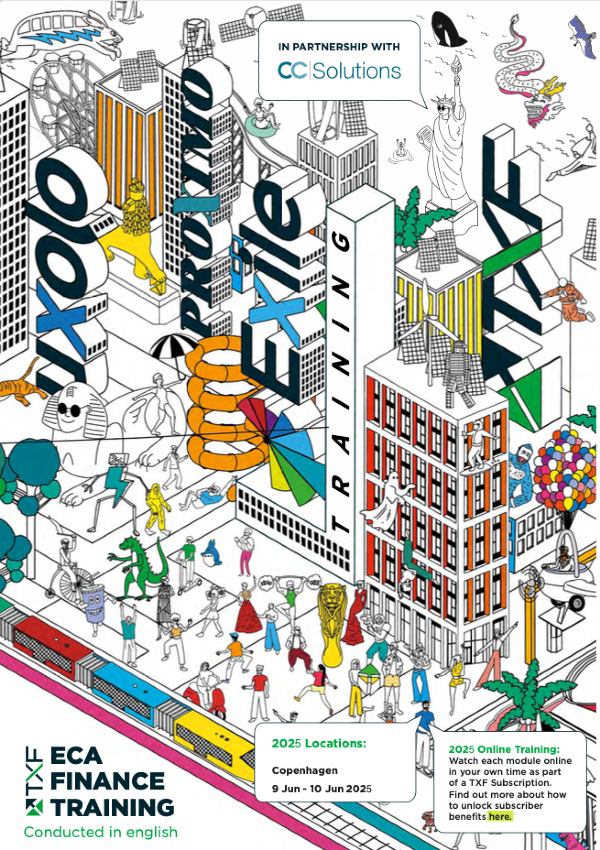Why are banks withdrawing from correspondent banking?
Banks are continuing to withdraw from many of their correspondent banking relationships - a process which threatens global trade, especially in poorer countries. TXF speaks to bankers to see whether anti-money laundering (AML) and know your customer (KYC) regulations are solely to blame for this trend and what can be done to mitigate it.

Banks are continuing to withdraw from many of their correspondent banking relationships – a process which threatens global trade, especially in poorer countries. TXF speaks to bankers about whether anti-money laundering (AML) and know your customer (KYC) regulations are solely to blame for this trend and how the withdrawal could be stemmed.
Banks are withdrawing from correspondent banking relationships, impacting access to payment services and global trade. A World Bank survey last year showed that nearly 75% of the internal banks surveyed were witnessing a decline in correspondent banking relationships.
Many blame heightened compliance demands in the form of anti-money laundering (AML) and know your customer (KYC) regulations for this withdrawal, but other factors also come into play in banks’ strategic exits.
“Derisking has accelerated at a head-spinning pace, so I think we are just catching up with the extent to which it took place,” says Steven Beck, head of trade finance at the Asian Development Bank (ADB). “It is still going on – some financial institutions have culled a great deal of relationships, and many are still in the process of culling.”
Correspondent banking is the provision of banking services by one bank (the ‘correspondent’) to another (the ‘respondent’). It forms the bedrock of much of international trade as it allows banks to make and receive international payments. Correspondent banking relationships (CBRs) are essential for exporters to access foreign currency services. If the correspondent of their local bank pulls out, they have no way to export because they cannot get foreign currency clearing. Traditionally banks maintained broad CBR networks, and having fewer correspondents makes small banks more vulnerable.
The World Bank (WB), Bank of International Settlements (BIS) and the Financial Stability Board all investigated the problem last year.
“It is something we are concerned about,” says Beck, "the entities that are going to be hurt most are the usual suspects: SMEs and emerging markets, especially the smaller ones.”
The World Bank surveyed 110 banking authorities, 20 large banks and 170 smaller local and regional banks to produce its report on correspondent banking. The report found about half the banking authorities surveyed and slightly more local/regional banks were seeing a decline in correspondent banking relationships. For large international banks the figure was much higher, at 75%.
Developing regions are hit hardest by the withdrawal. In Europe and Central Asia, over 80% reported moderate or significant decline in CBRs. Latin America and the Caribbean were also significantly affected, with 66% of banks reporting a decline. In Africa 51% of banks reported a decline. There’s a domino effect with correspondent banks following suit in exiting a market. The decline in foreign CBRs affected check clearing, clearing and settlement services, and trade finance (particularly letters of credit) most.
Some see this trend as part of a natural cycle in an industry continually reassessing risk. Dominic Broom, head of sales and relationship management for EMEA at BNY Mellon, tells TXF: “There will always be a natural ebb and flow to relationships, so there will be activities that we selectively decide to move away from. We have, in a very small number of cases, decided to close relationships.”
Others see the withdrawal as abnormal in its extent, and linked to a tightening of the regulatory environment. Rudolf Putz, head of the trade facilitation programme at the European Bank of Reconstruction and Development (EBRD), says withdrawal started about seven years ago after the financial crisis, as a wave of fear came over markets and banks pulled out of the emerging economies.
Speaking to TXF in January, Daniel Schmand, chair of the International Chamber of Commerce, said the average cost of maintaining a correspondent banking relationship had increased from $40,000 to $75,000. With 7,000 banks worldwide maintaining one million correspondent banking relationships, this is a huge overall cost to the economy.
While a majority (62%) of banks responding said they easily found replacement relationships, 28% said it was difficult to find alternatives, and some noted a substantial increase in pricing. The problem is not only whether alternatives can be found, but the cost in time and labour incurred in establishing them.
Putz says: “We are regularly seeing examples of banks in the countries we cover who have to stop all their trade finance activities.”
The broader concern, the World Bank report says, is that with larger banks terminating relationships with high-risk customers, the system ends up pushing risk to less transparent channels, or excluding legitimate customers – thus actually increasing overall risk. Money will not simply stop flowing if legitimate channels are closed. If withdrawals continue they may have the perverse effect of making it harder for authorities to prevent financial crime and financing of terrorism. In emerging economies trying to tackle corruption and the informal economy, this spells disaster. These are also the economies which most need access to finance to build infrastructure.
The World Bank report identifies money transfer operators as the highest perceived risk counterparties. These operators are crucial for remittances, which in turn keep food on the table of countless families in developing economies. Somalia, for example, receives $110 per capita in remittances, which amounts to 35% of GDP. In February the Merchants Bank of California, specialised in money transfers, announced it would close the accounts of all Somali-American money transfer companies on its books. Countries covered by the EBRD, such as Tajikistan and Moldova, also rely heavily on remittances and would be devastated by these flows drying up.

Banks' exit from correspondent relationships has a knock-on effect on economies such as Somalia's, which relies heavily on remittance flows. Flickr: AMISOM
An unintended consequence of regulation?
To say the withdrawal is driven by higher regulatory controls is to ignore the full complexity of the factors contributing to an overall derisking. Broom says: “There are numerous costs we have to factor in. Compliance costs are one of these and investment in infrastructure is another. Both sets of costs have been rising above the inflation rate and above the rate we charge for our services.”
It costs a bank the same, or even more, to do compliance for a small bank offering limited business as a larger bank offering more opportunities. This has the unfortunate effect of blocking out the most vulnerable from correspondent relationships.
“Regulation has made it more costly and time consuming to engage in correspondent banking relationships, but regulation alone does not stop these relationships – it is still a commercial decision to do so,” says Putz.
Yet many banks point to regulation’s ‘unintended consequences’ causing them to withdraw from CBRs.
Marc Auboin, economic counsellor for trade and finance at the World Trade Organisation, tells TXF: “There is no fact-based, global evidence that KYC is having an impact on restricting banking in under-developed areas. There are anecdotal evidences.
“The WTO is interested in clarifying the debate with other international organizations. But to do that we need more data and facts, to see in effect whether there are serious potential or real unintended consequences of regulation on trade flows.”
Derisking is a complex trend driven by many factors besides heightened regulation.
Falling commodity prices are one: they have sent country risk and payment risk skyrocketing in emerging markets. “With the commodity price crash, there is less demand for commodity financing, which means all international banks are currently earning less on their correspondent banking relationships,” says Auboin.
Part of the difficulty in understanding and addressing this issue is that the impact of regulation cannot easily be quantified. Compliance decisions involve a measure of subjective judgment by an institution over a client’s riskiness, and uncertainty has led banks to play it safe and be especially risk-averse. The reluctance to maintain relationships in riskier markets is about compliance but also about reputational damage. There’s a similar dynamic in markets touched by sanctions: even where there is no legal infringement involved in engaging with certain companies, banks are wary of the reputational damage those relationships could wreak. Fines such as the £7.6 million imposed on Standard Bank in 2014 for failure to implement sufficient money-laundering controls add to a generalised case of cold feet.
The extent of the withdrawal itself has only recently been quantified by reports. Banks are understandably reluctant to provide data on the extent of their withdrawal, so it’s difficult to see how severe the problem is. “A lot of people in the industry are shy to say they have exited 7000 banking relationships and pulled out of three or four countries entirely,” says Beck.
“I think there has been a great deal of derisking.” says Beck who adds the process is still continuing as banks keep “culling” many CBRs.
Broom suggests the culling is driven not only by correspondents but also respondents: “Correspondent banking is both a buyer and a seller relationship. Buyers of services are also looking to ensure they have the right number of correspondents.” So the withdrawal might partly be driven by an overall rationalisation of the number of relationships it’s necessary to maintain. “What cannot be doubted is that the cost of doing correspondent banking has risen for all parties, so all parties are having to be more selective as to who they work with,” he says.
Many banks are adapting their business models to the new regulatory restrictions, just as others opt to cut their losses and exit relationships. The fact larger banks are cutting back most perhaps indicates their global spread limits their adaptability to change. Banks which overstretched their operations across many markets might, in exiting, leave space for institutions with more focused footprints – and this may be a good thing for these markets, suggests Broom: “One is increasingly seeing selective specialism in certain markets or segments. Numerous institutions that tried to operate successfully across multiple regions or segments have failed in that quest.”
Streamlining a regulatory ‘spaghetti bowl’
It is too simplistic to blame regulation for the withdrawal, and it is also not constructive; regulation is not a temporary nuisance that might go away, it is a permanent feature of the financial system which is likely to be ramped up, not watered down, over the next few years. Efforts should not be aimed at railing against the regulators, but at streamlining the regulatory process to minimise cost, and adapting business models to absorb the cost better. “Regulation can be streamlined across different states, and this is ultimately advantageous if it’s done with the end user in mind,” says Broom.
Regulation is sometimes duplicated by different institutions, and there remains uncertainty about punitive measures as banks adapt to tightening controls. Beck says: “What you have got is a spaghetti bowl of requirements and regulations that overlap and aren’t harmonised between regulators. The result of that lack of harmonisation is a very confusing mix of requirements.
“No one wants to be indirectly supporting crime. The question is how to get the balance right and do it in such a way that we have the fewest unintended consequences, and the least negative impact on economic growth and job creation.”
Information sharing is one powerful way to avoid duplicating due diligence. Organisations such as SWIFT, which provide the infrastructure for correspondent banking systems, have a role to play in this. The ADB are increasing awareness of SWIFT’s KYC Registry, which the WB and BIS reports also highlight as a powerful tool in streamlining compliance. Widespread adoption of Legal Entity Identifiers, unique 20-digit codes identifying participants in transactions, would go some way to making it easier to comply to KYC.
Development banks share information to signpost their focus markets for large international banks. “We help small and medium-sized banks in emerging markets to standardise their reports to be acceptable to a high number of correspondent banks,” says Putz. “We have very tough conditions, so once a bank has been approved by the EBRD there is a high likelihood that it will be acceptable to large banks.”
The ADB provides the same service, posting information about banks on its website. These services ensure larger banks get the necessary information about counterparties that are eligible, without having to waste time on those that aren’t. The EBRD covers up to 100% of the payment risk and cover risk of engaging in a correspondent relationship with a bank it has screened. Some banks would not have access to loans if it weren’t for the EBRD, particularly in small CIS countries like Belarus or Ukraine.
“I think our partner banks are really happy with our services,” says Putz. “They are using us more than they did in the past, they rely more on us. International banks are looking much more at risk cover and at our partner banks.”
This increase in reliance on development banks such as the EBRD is both a symptom of the squeeze and an indication that constructive solutions are being developed.
A silver lining?
Treasuries around the world are both in favour of increased transparency and increased access to finance and trade. A trade-off between these aims is unsustainable and unhealthy for the global economy. One area to work on is smoothening the kinks in regulation. The Financial Action Task Force aims to complete work on clarifying regulatory expectations for its plenary meetings in June and October of this year.
As regulators and financiers tackle the implications of new levels of regulatory oversight, new technologies could help them make the efficiency gains necessary to absorb the cost of heightened regulation and maintain correspondent relationships. “Technology has the potential to be a complete game changer,” says Beck.
More research is needed along with more onboarding to information sharing programmes such as the KYC Registry. A clearer understanding of the underlying causes of withdrawal will come further down the line, and in the meantime, “we can only try to stop this trend and reverse it,” says Putz.
Join Parvaiz Dalal, Managing Director at Citi on June 7 & 8, as he tries to answer the question: Can banks still afford to finance trade?
This industry duel will be held at TXF Trade, FinTech & Treasury, taking place at Glazier's Hall, London. Senior participants will discuss the rising cost of compliance, falling prices and intensifying capital constraints.
Take a look into the future of this industry and join the guest list here.

.jpg)




